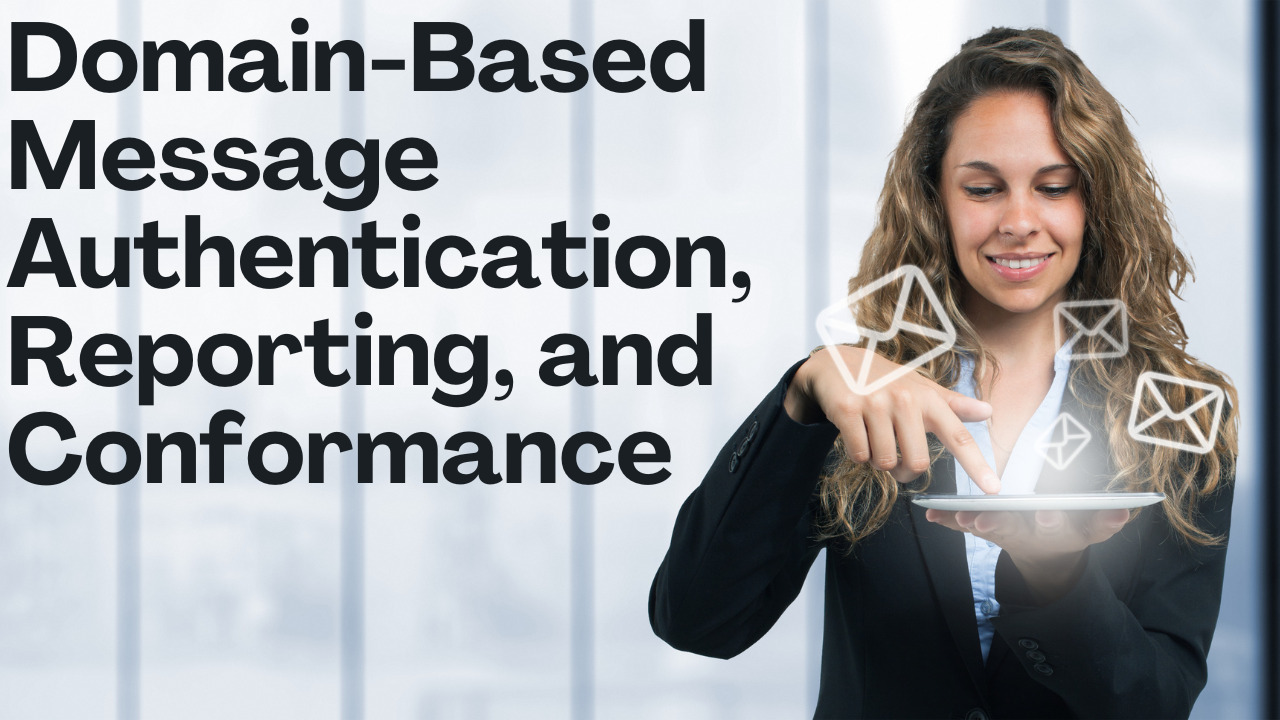Domain-Based Message Authentication, Reporting, and Conformance: Enhancing Email Security and Trust
Domain-based Message Authentication, Reporting, and Conformance, commonly known as DMARC, is an email authentication protocol that seeks to reduce phishing attacks and improve email security. By building upon existing specifications such as SPF (Sender Policy Framework) and DKIM (DomainKeys Identified Mail), DMARC allows domain owners to establish policies that define how their email is authenticated and what should happen if authentication fails. As a domain owner, you can protect your email communications from being fraudulently used in spam or phishing campaigns.
Implementing DMARC can be an important step in safeguarding your company’s email reputation and the inboxes of your clients and employees. With the rising threats of email fraud and impersonation, DMARC provides a mechanism for email receivers to report to senders about messages that pass and/or fail DMARC evaluation. As a result, you gain insights into how your email domain is being used, enabling you to take action against unauthorized use of your domain in email correspondence.
Key Takeaways
- DMARC enhances email security by leveraging SPF and DKIM to prevent email spoofing.
- As a domain owner, you are empowered to set the policy for handling emails that fail authentication.
- Implementing DMARC provides valuable reporting, helping maintain the integrity of your domain’s email ecosystem.
Overview of DMARC
As you navigate the complexities of email security, understanding DMARC is essential for safeguarding your domain against unauthorized use and enhancing the integrity of your email communication.
Purpose of DMARC
DMARC stands for Domain-based Message Authentication, Reporting, and Conformance. It’s an email authentication protocol you can use to protect your domain from being exploited for email spoofing, phishing scams, and other cyber threats. Its primary purpose is to enable email domain owners to declare their email authentication practices and specify how receiving email servers should handle emails that don’t align with these practices.
How DMARC Works
DMARC leverages two existing email authentication techniques: the Sender Policy Framework (SPF) and DomainKeys Identified Mail (DKIM).
- SPF allows senders to define which IP addresses can mail for a particular domain.
- DKIM provides a way to sign and verify emails at the message transfer agent level using public key cryptography.
When a receiving email server gets an incoming email, it checks the DMARC policy published in the DNS records of the sender’s domain to verify the email’s SPF and DKIM authentication results. If the email fails to authenticate, DMARC guides the receiving server on handling these messages based on the policy set by the sender (e.g., reject the email or flag it as suspicious).
Benefits of Implementing DMARC
Implementing DMARC on your domain has several benefits:
- Enhances Email Security: It adds an extra layer of verification to prevent attackers from impersonating your domain to send malicious emails.
- Increases Deliverability: Legitimate emails are less likely to be marked as spam by receiving servers when you follow proper DMARC practices.
- Improves Visibility: You receive reports on email delivery and understand how your email domain is being used, making it easier to identify and respond to unauthorized email activity.
Technical Details
In the intricate realm of email authentication, your understanding of the technical details of DMARC is essential to securing your email communications. This will also minimize the chances of your domain being exploited for email spoofing and phishing attacks.
DMARC Record Structure
Your DMARC record is a TXT record published in the DNS for your domain and consists of a series of tags that define its functionality. Each tag provides specific instructions to the receiving mail server. For example, the v tag indicates the DMARC version (DMARC1), the p tag specifies the policy (none, quarantine, or reject), and the rua tag gives the reporting URI for aggregate reports. Properly structuring this record is crucial for the deployment of DMARC.
SPF and DKIM in DMARC
DMARC utilizes two existing email authentication techniques: Sender Policy Framework (SPF) and DomainKeys Identified Mail (DKIM).
- SPF allows you to define which mail servers are permitted to send email on behalf of your domain.
- DKIM provides an encryption key and digital signature that verify that an email message was not altered during transit.
DMARC relies on the results of SPF and DKIM checks to determine the authenticity of an email. The message is considered authentic if either the SPF or DKIM checks pass and are aligned with the domain.
DMARC Policy Alignment
Policy alignment in DMARC determines how strictly the policy you set is to be enforced based on the results of the SPF and DKIM checks. There are two types of alignment:
- Relaxed alignment: The domain in the
From:header matches the domain in the SPF or DKIM signature but does not require an exact match of subdomains. - Strict alignment: The domains must match exactly for DMARC to pass.
Choosing the correct alignment is essential in balancing security with the deliverability of legitimate emails.
Policy Configuration
Configuring a DMARC policy is crucial to protecting your domain against email abuse. This section guides you through understanding the components of DMARC policy, setting up your record, and choosing the appropriate policy mode for optimal email authentication.
DMARC Tags Explained
DMARC records comprise various tags defining email authentication practices and reporting mechanisms. Each tag serves a specific function:
v=DMARC1: This tag identifies the record as a DMARC record, and it is always the first tag in a DMARC record.p=: The policy tag indicates how receiving mail servers should handle non-aligned emails. Your policy can be denied, quarantined, or rejected.rua=: Specifies where aggregate reports of DMARC results should be sent.ruf=: Provides an address for sending forensic reports of specific failures in message authentication.pct=: Defines the percentage of messages to which the DMARC policy applies.aspf=: Dictates the SPF alignment mode, either strict or relaxed.adkim=: Outlines the DKIM alignment mode, also either strict or relaxed.
Creating a DMARC Record
A DMARC record is a TXT record in your domain’s DNS settings. To create your DMARC record, follow these steps:
- Define the policy: Start with the
v=DMARC1tag and decide on your policy (p=none/quarantine/reject). - Specify email addresses: Add
rua=andruf=tags to define where reports should be sent. - Set policy application: Choose the percentage of emails to apply the policy to with the
pct=tag. - Specify alignment modes: State how strictly SPF and DKIM should align using
aspf=andadkim=tags. - Compile the record: Combine all the tags in a single string.
- Publish the record: Add this string as a TXT record to your domain’s DNS settings.
Policy Modes (None, Quarantine, Reject)
The policy mode tag p= in your DMARC record dictates the course of action a receiving mail server should take when encountering an email that fails DMARC validation:
p=none: This provides no specific action, merely monitoring. You’ll receive reports, but your emails will not be affected.p=quarantine: The receiving server could place emails that fail DMARC checks into the spam or junk folder.p=reject: The strongest policy, telling receiving servers to reject emails that fail DMARC checks outright.
Choose the mode that aligns with how you want to enforce email authentication for your domain.

DMARC Reporting
DMARC reporting is a critical feature that provides insight into your email traffic by delivering reports on authentication results. These reports allow you to monitor and address email authentication issues effectively.
Aggregate Reports
Aggregate reports (RUA) are XML documents sent by email receivers to the address specified in your DMARC record. You can expect to receive them:
- Frequency: Daily
- Contents: Aggregate data about messages claiming to come from your domain.
This data includes:
- Volume of messages
- IP addresses of senders
- Information about SPF and DKIM verification
- DMARC evaluation outcome
Consider using a DMARC report analyzer to examine these reports for easier interpretation.
Forensic Reports
Forensic reports (RUF) are detailed reports triggered by individual email failures. These reports:
- Trigger: Sent when a message fails DMARC authentication and policy evaluation.
- Details: Provide specifics on why a message failed along with headers, aligning with privacy and policy concerns.
Here are the typical components you’ll find in a forensic report:
- Subject line of the email
- Identifiers like the source IP
- Authentication results for SPF, DKIM, and DMARC
Use these reports for immediate analysis of authentication failures and active issue resolution.
Implementation Best Practices
Implementing DMARC effectively fortifies your email system against abuse. Following these best practices allows you to set up and adjust your DMARC policies for optimal performance and security.
Initial Setup Steps
- Verify Domain Ownership: Ensure that you have control over the DNS records of your domain. This verification is fundamental before you proceed with any changes to the DNS entries.
- Publish an SPF Record: Create an SPF record to specify which mail servers can send email on your domain’s behalf.
- Implement DKIM: Set up DomainKeys Identified Mail to add a digital signature to your emails, which aids in verifying that the messages haven’t been tampered with.
- Create a DMARC Record: Once SPF and DKIM are in place, publish a DMARC record in your DNS. Start with a
p=nonepolicy to monitor the impact without affecting your email flow.
Policy Tag Purpose Recommended Value vProtocol version DMARC1 pPolicy for domain none ruaReporting URI for aggregate mailto@domain.com rufReporting URI for forensics mailto@domain.com - Test Your Configuration: Utilize DMARC testing tools to confirm that your SPF, DKIM, and DMARC records are correctly formatted and recognized.
Monitoring and Adjusting Policies
- Monitor Reports: Regularly review the aggregate and forensic reports sent by email receivers. These reports provide insights into the performance of your email authentication setups.
- Analyze and Refine: Analyze the data for unauthorized use of your domain and adjust your SPF and DKIM records to prevent legitimate emails from failing authentication.
- Tighten the Policy: Gradually move from a
p=nonepolicy to a more restrictivep=quarantineorp=rejectpolicy to actively prevent unauthenticated emails from being delivered, based on the analysis of the reports.
By methodically setting up and adjusting your DMARC configuration, you enhance your email security posture and protect your domain from being used in phishing attacks or other fraudulent activities.
Troubleshooting Common Issues
When implementing DMARC, understanding how to address failures and configuration errors is crucial. This section guides you through the analysis of DMARC failures and common configuration mistakes to help maintain the integrity of your email authentication setup.
Analysis of DMARC Failures
If you encounter DMARC failures, it’s important to first pinpoint their reason. Examine your DMARC reports to identify patterns or recurring issues. A failure can occur if emails are not aligned with the DMARC policy, meaning they do not pass SPF or DKIM authentication, or if the sending sources are not authorized in your DMARC record. You should:
- Review: Inspect SPF and DKIM records to ensure they are valid and correctly set up.
- Test: Use online DMARC, SPF, and DKIM testing tools to confirm your email systems are properly configured.
- Monitor: Regularly analyze DMARC reports for unauthorized email sources and alignment issues.
Common Configuration Mistakes
A well-configured DMARC policy is pivotal for it to function effectively. Common mistakes may include:
- Syntax Errors: Ensure that your DMARC record follows the correct syntax. Misplaced semicolons or incorrect tags can lead to parsing errors.
- Propagation Delays: After updating your DNS records, allow sufficient time for changes to propagate across the internet.
- Misunderstanding of Policy Flags: Know the difference between
p=none,p=quarantine, andp=rejectto choose the appropriate policy for your domain. - Inaccurate SPF Records: Avoid having too many DNS lookups in your SPF record, which could exceed the limit and result in SPF failures.
DMARC Adoption
As you consider implementing email security measures, understanding DMARC’s growing adoption is crucial. The protocol has been instrumental in defending against email spoofing by allowing domain owners to specify how email from their domains should be handled.
Global Adoption Rates
DMARC adoption varies across regions and industries despite its importance in email security. Your awareness of these rates is pivotal:
- High Adoption: Industries like banking and finance have a higher adoption rate due to the sensitive nature of their communications.
- Moderate Adoption: General business sectors show a moderate level of implementation as awareness of DMARC benefits becomes more widespread.
- Low Adoption: Small businesses and some countries with less regulatory oversight are slower to adopt DMARC protocols.
A table to illustrate:
| Region/Industry | Adoption Rate |
|---|---|
| Banking & Finance | High |
| General Business | Moderate |
| Small Business | Low |
Adoption Challenges
- Technical Complexity: Setting up DMARC can be technically challenging. It requires careful configuration of the DNS and an understanding of SPF and DKIM protocols.
- Awareness & Resources: Lack of awareness and resources to implement DMARC protocols can hinder adoption, particularly in regions with less developed IT infrastructure.
By addressing these challenges, you can help promote broader DMARC adoption and enhance email security for your domain.
Legal and Compliance
In the realm of email communication, compliance with legal standards is paramount. Your understanding of DMARC’s role in this context is crucial for ensuring that your domain’s email practices meet legislative expectations and data protection requirements.
Legislation and Email Authentication
You must know that various countries have enacted laws requiring businesses to take measures against email fraud and phishing. For instance, in the United States, the CAN-SPAM Act sets commercial email requirements, including penalties for sending misleading messages. While DMARC itself isn’t legally mandated, its adoption can help you comply with such laws by authenticating that emails from your domain are legitimate and by allowing you to specify how unauthenticated emails should be handled.
DMARC and Data Protection Regulations
In addition to complying with anti-spam laws, DMARC aligns with data protection regulations such as the EU’s General Data Protection Regulation (GDPR). GDPR mandates personal data protection and can impose fines for security breaches. By using DMARC, you can enhance your email security posture, helping to prevent unauthorized access to sensitive data sent via email. Your proper implementation of DMARC can demonstrate your commitment to GDPR’s data security principles, potentially mitigating legal risks associated with email communication.
Case Studies and Statistics
In this section, you will find a targeted exploration of how DMARC has been applied across different sectors and a breakdown of its effects through statistical lenses.
Effectiveness in Various Sectors
DMARC’s efficacy is not monolithic; it varies significantly across industries due to differences in implementation strategies and the nature of email communication within those sectors. For instance:
- Financial Services: Institutions often see a drastic reduction in phishing attacks after DMARC implementation, as the protocol effectively helps block spoofed emails.
- Healthcare: DMARC aids in protecting sensitive health information by ensuring that emails are authenticated, thus supporting compliance with regulations like HIPAA.
Statistical Analysis of DMARC Impact
Adopting DMARC can lead to measurable changes in an organization’s security stance. Consider the following statistics:
- Phishing Prevention: Post-DMARC adoption, organizations can experience up to a 70% reduction in phishing emails.
- Email Deliverability: Legitimate email delivery rates often increase, as DMARC helps to establish the authenticity of the sender’s domain, improving trust with receiving servers.
Use DMARC reports to continuously analyze and refine your email security posture, ensuring ongoing protection against evolving threats.








